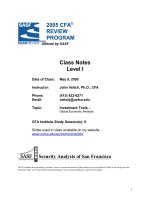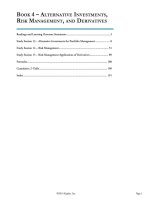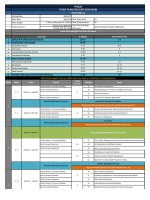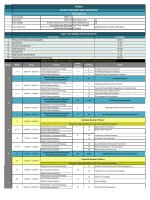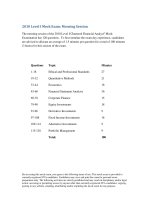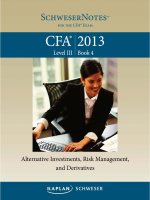CFA Level I - Study Session 6
Bạn đang xem bản rút gọn của tài liệu. Xem và tải ngay bản đầy đủ của tài liệu tại đây (231.71 KB, 11 trang )
2005 CFA
®
REVIEW
PROGRAM
Offered by SASF
Class Notes
Level I
Date of Class: May 9, 2005
Instructor: John Veitch, Ph.D., CFA
Phone: (415) 422-6271
Email:
Topic: Investment Tools –
Global Economic Analysis
CFA Institute Study Session(s): 6
Slides used in class available on my website -
www.usfca.edu/economics/veitch/
Security Analysts of San Francisco
The CFA Institute does not endorse, promote, review or warrant the accuracy of the products or services offered by SASF or the verify pass rates
claimed by SASF. CFA
and Chartered Financial Analyst
are a licensed trademarks owned by CFA Institute.
1
CFA Level I - Study Session 6
1. A. “Gaining from International Trade”
The candidate should be able to:
a. state the conditions under which a nation can gain from international trade;
Nations can gain from trade if they produce goods in which they have a comparative
advantage and trade for goods in which they have a comparative disadvantage.
• Comparative Advantage is the ability to produce a good at a lower opportunity cost
than others can produce it.
• As long as the relative costs of production differ across nations, gains from
specialization and trade will be possible.
When nations produce and trade based on Comparative Advantage trade between nations
leads to an expansion in total world output and mutual gains to each nation.
b. discuss the effects of international trade on domestic supply and demand;
When product can be transported long distances at low cost (relative to its value) then
domestic price of the product is determined by world demand and supply
Trade & specialization thus results in:
1. Lower prices and higher domestic consumption for imported products.
• Domestic Consumers benefit from trade
2. Higher prices and higher domestic production for exported goods.
• Domestic Producers benefit from trade.
c. describe commonly used trade-restricting devices including tariffs, quotas, voluntary export
restraints, and exchange-rate controls;
Commonly used trade-restricting policies are:
I. Import Tariff – are a tax on goods and services imported into the country.
II. Import Quota – puts an upper limit on the amount of a good or service that is
allowed to be imported into the country.
III. Voluntary Export Restriction (VER) – an agreement by foreign firms to limit the
amount of a good or service they will export into the country
IV. Exchange Rate Controls – when the government either sets the exchange rate at a
rate above the market rate or it limits the access to foreign currency by its citizens.
Effect is to make imports into the country more expensive and reduce trade.
d. explain the impact of trade barriers on the domestic economy and identify who benefits
and loses from the imposition of a tariff;
Trade restrictions promote inefficiency and reduce the potential gains from trade for the
domestic economy. Thus trade restrictions are harmful to the wealth of the economy.
Tariff is a tax levied on imports, has following effects:
2
i) Domestic Price rises by amount of tariff.
ii) Reduction in the quantity of imports of the good.
iii) Loss of consumer surplus as less of good consumed at higher price.
iv) Gain of producer surplus as domestic production increases.
v) Government revenue increases from tariff revenues.
vi) Net Deadweight loss to society.
Effects of an import quota are similar to those of a tariff but involve a larger deadweight loss
because it generates NO revenue for the government as a result of the quota.
e. explain why nations adopt trade restrictions;
• Power of Special Interests : Trade restrictions provide concentrated benefit to small
groups while imposing widely-dispersed costs on majority of nation. Thus politicians
often have the incentive to favor trade restrictions even though they hurt economic
efficiency.
• Economic Illiteracy: Many fallacies associated with arguments for trade barriers.
(1) Trade restrictions that limit imports save jobs for Americans.
(2) Free trade with low wage countries will reduce the wages of Americans.
Both statements are untrue and ignore the effects of trade based on comparative advantage
on the welfare of the nation as a whole and the effects of specialization in what we are
comparatively good at on our standard of living.
f. discuss the validity of the arguments for restrictions.
Trade barriers are generally harmful to level and growth of economic well-being in a country, with
the following exceptions:
Partially Valid Economic Arguments
i) National Defense: Certain industries “vital”, must be protected.
• Argument has some validity but often abused as relatively few industries are truly
vital to our national defense.
ii) Infant Industry: New industries “need protection” until established.
• Argument is valid as stated but generally abused. More often used to cushion
industries from international competition rather than provide temporary shelter
while they become internationally competitive.
iii) Anti-Dumping: Domestic producers “need protection” from foreign suppliers
selling products below cost (dumping).
• Often considerable ambiguity about whether true dumping is occurring or not.
Dumping aimed at eliminated domestic competitors should be met with tariffs.
Other types of dumping should not be met with tariffs but other policies, such as
income supplements to affected industries.
3
2. A. “Foreign Exchange” **** New Text and Changed LOS for 2004
The candidate should be able to
a) define direct and indirect methods of foreign exchange quotations;
Direct Method: (Domestic on top)
• # units of home currency per unit of foreign currency ($0.01 US$/Yen)
Indirect Method: (International on top)
• # units of foreign currency per unit of home currency (100 Yen/US$)
One method is simply the inverse of the other.
b) calculate the spread on a foreign currency quotation;
Bid or Buy rate: Exchange rate at which agent (the bank) will buy a currency.
Ask or Sell rate: Exchange rate at which agent (the bank) will sell a currency.
[ ]
Ask Rate - Bid Rate
Bid-Ask Spread= 100
Ask Rate
×
c) explain how spreads on foreign currency quotations can differ as a result of market
conditions, bank/dealer positions, and trading volume;
Anything that increases the dealer’s risk of holding the foreign currency will increase the Bid-
Ask spread.
• Increased volatility in spot market conditions or lack of spot market liquidity.
• Bank/dealer positions are more likely to influence the midpoint exchange rate
quote [ = (bid+ask)/2 ] than the size of the bid-ask spread for a currency.
d) convert direct (indirect) foreign exchange quotations into indirect (direct) foreign exchange
quotations;
• When there is NO Bid-Ask spread
o
1
Direct Exchange Rate =
Indirect Exchange Rate
• When there is a Bid-Ask Spread
o
1
Direct ASK Exchange Rate =
Indirect BID Exchange Rate
• Rate to sell domestic currency equals the reciprocal of the rate to buy the foreign
currency.
o
1
Direct BID Exchange Rate =
Indirect ASK Exchange Rate
• Rate to buy domestic currency equals the reciprocal of the rate to sell the foreign
currency.
4
e) calculate currency cross rates, given two spot exchange quotations involving three
currencies;
Please see my slides for what I think is a better way to do this. The following is a summary of
the book’s approach which I think is confusing.
Let FC
1
and FC
2
be the two foreign currencies for which the cross-rate is desired. Let DC be
the vehicle currency against which each foreign currency is quoted. The vehicle currency is
generally the US dollar (USD). I will take FC
1
= Japanese Yen (¥) and FC
2
= Euros (€) for
concreteness below.
Cross – Ask
1 1
2 2
ask ask ask
FC FC
DC
=
FC DC FC
÷ ÷ ÷
or
( ) ( ) ( )
ask ask ask
USD
¥ ¥
=
€ USD €
Cross – Bid
1 1
2 2
bid bid bid
FC FC
DC
=
FC DC FC
÷ ÷ ÷
or
( ) ( ) ( )
bid bid bid
USD
¥ ¥
=
€ USD €
The nice thing about the above is that to calculate a cross - ask (bid) you use ask (bid) rates.
The confusing thing is that one is quoted as indirect and the other is quoted as direct. As long
as you keep the units straight I guess you’ll be ok.
If you don’t like this approach, go to my slides. Everything there is quoted in DIRECT terms
and the formulas are laid out with only Direct quoted exchange rates.
f) distinguish between the spot and forward markets for foreign exchange;
Spot market: Currencies traded for immediate delivery.
Forward Market: Trade contracts to buy or sell a specified amount of currency at a specified
future date at the specified forward exchange rate. Forward contracts are customized to
customer needs in contrast to futures contracts which have fixed sizes and maturity dates.
5
